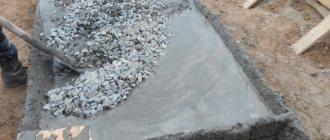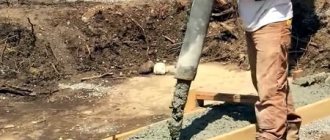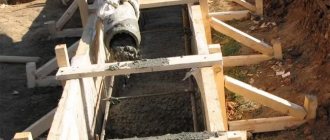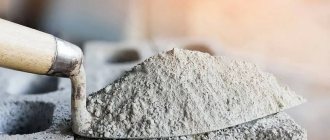In concrete, cement is the compound that binds all its components. The technical characteristics of the solution depend on its quantity and quality - strength, frost resistance, water resistance, corrosion resistance. As part of the mixture, the price for it is the highest, so the issue of cement consumption per 1 cubic meter of concrete is acute - too much, the profitability of construction will decrease, cracks will appear after hardening, too little - the required technical and operational characteristics will not be achieved.
What does consumption depend on?
The main requirement for concrete is to achieve the required strength after hardening. Based on this, in accordance with construction standards describing the quality of components, their ratio and technical characteristics are selected. This is done taking into account the strength grade of the composition; the recommended ratio of ingredients is indicated in specialized reference books. To calculate how much cement will be contained in 1 m³ of concrete, the following factors are taken into account:
- brand, density, required setting time;
- plasticity of the solution and its mobility;
- type of sand, fraction, presence of impurities, the proportion of which does not exceed 15%, otherwise this filler is subjected to pre-treatment - sifting or washing;
- fraction, type and other technical characteristics of crushed stone - flakiness, density, contamination, if it exceeds the norm, the crushed stone is cleaned;
- the presence of additional components that improve characteristics - hardeners or plasticizers.
During production, the brand of Portland cement is taken into account. It should be twice the grade of the composition made from it - for the M200 solution, take the M400 composition. The higher the brand, the less it will be needed to prepare the mixture of the required class.
Calculation of the amount of water
To prepare concrete you need water. Determining its quantity plays the same important role as the calculation of other components. Usually a ratio of 1:2 is used, that is, 1 bucket of water to 2 buckets of dry mixture. But this is a very rough estimate. In fact, the amount of water is adjusted for different brands of concrete.
For example, if you take M400, M500 cement, then for M200 concrete you need 0.69 liters of water per 1 kg of dry mixture, for M250 concrete - already 0.57 liters of water, and for M300 concrete - 0.53 liters. It is better to take a more accurate proportion, this will improve the characteristics of concrete. But it will still have to be adjusted experimentally at the construction site, because the moisture content of the sand will also need to be taken into account.
Drawing up proportions
To calculate the amount of cement spent on a cube of concrete, you need to know the brand of the mixture; in addition, the brand of the binder used is also taken into account. The proportional ratio of the components is indicated in special tables. In construction, M400-M500 are more often used, and the proportion is calculated in mass parts.
For M400:
| Concrete grade | Proportion by mass C/P/Shch |
| 100 | 1/4.6/7 |
| 150 | 1/3.5/5.7 |
| 200 | 1/2.8/4.8 |
| 250 | 1/2.1/3.9 |
| 300 | 1/1.9/3.7 |
| 400 | 1/1.2/2.7 |
| 450 | 1/1.1/2.5 |
For M500:
| Concrete grade | Proportion by mass C/P/Shch |
| 100 | 1/5.8/8.1 |
| 150 | 1/4.5/6.6 |
| 200 | 1/3.5/5.6 |
| 250 | 1/2.6/4.5 |
| 300 | 1/2.4/4.3 |
| 400 | 1/1.6/3.2 |
| 450 | 1/1.4/2.9 |
This means that to prepare M300 concrete from M400 cement you will need to take 10 kg of cement, 19 kg of sand, 37 kg of crushed stone. The result will be 66 kg of finished material. The average density of the mixture is 2200 kg/m³, so the mass of the binder component consumed is 2200/66*10≈330 kg. Such calculations have already been compiled into special tables to facilitate the work of designers and builders.
When calculating the amount of solution, take into account that the volume yield is less than the total volume of all components due to compaction during mixing. The most popular fraction of crushed stone is 20 mm, it provides the required strength and is affordable. The amount of added water required to prepare 1 cube of the mixture is determined during the manufacturing process, since it depends on the moisture content of the sand used and the technical parameters of the mixture.
Consumption rates for different solutions
The mass of binder in 1 m3 of solution may vary depending on the use of concrete. Today it is needed to solve the following problems:
- creating a foundation;
- bricklaying;
- pouring screed;
- plaster walls.
All these works require the builder to create a concrete mixture of a certain type with the required amount of cement. The highest costs of material occur when laying brick or plastering walls. The lowest costs occur when pouring foundations and screeds, since such mixtures contain fillers.
Cement consumption for plaster
Costs depend on the condition of the walls, layer thickness and brand of binder. Below is a table in which you can see the proportions of mixing Portland cement and sand for different brands of mortar.
| Binder | Brand of solution | |||
| 100 | 75 | 50 | 25 | |
| M600 | 1:4,5 | 1:6 | – | – |
| M500 | 1:4 | 1:5 | – | – |
| M400 | 1:3 | 1:4 | 1:6 | – |
| M300 | 1:2,5 | 1:3 | 1:4,5 | – |
| M200 | – | 1:2,5 | 1:3 | 1:6 |
For a better understanding, let's look at an example: using M75 mortar and M400 Portland cement, you need to plaster the surface of a wall with an area of 50 m2. The thickness of the plaster layer is 2 cm (0.02 m).
The solution is prepared by mixing the main components in a ratio of 1:4. The cost rate of binder per 1 cubic meter of plaster is calculated using the following algorithm:
- Find the volume per 1 m2 by multiplying the width, height and depth. The result is: 1×1×0.02=0.02 m3 of mixture. Since the solution is mixed 1:4, it turns out that a fifth of the solution is cement, and 4/5 of the part is sand. As a result, we get: 1/5×0.02=0.004 cubic meters of cement and 4/5×0.02=0.016 cubic meters of sand.
- The entire area is 50 m2, it turns out: 0.004×50 = 0.2 m3 of binder and 0.016×50 = 0.8 m3 of sand.
- The average density of cement is 1300 kg/m3, and sand - 1600 kg/m3.
- As a result, we obtain the following component costs: 0.2×1300=260 kg of cement and 0.8×1600=1280 kg of sand
Machine plastering of walls
All calculations are easy to perform, the main thing is to choose the right type of binder and brand of mortar. The calculations themselves will take no more than 5-10 minutes.
Cement consumption for masonry
When calculating the material consumption for bricklaying, the type of binder material and the type of masonry, as well as the required brand of mortar, are taken into account. The rate of consumption of cement and sand in cubic meters depends on these factors. The standards are shown in the table below.
| Brick type | Wall thickness in bricks | ||||
| half a brick (120 mm) | 1 brick (250 mm) | one and a half bricks (380 mm) | in two bricks (510 mm) | 2.5 bricks (640 mm) | |
| Regular (250x120x65 mm) | 0,189 | 0,221 | 0,234 | 0,240 | 0,245 |
| One and a half (250x120x88 mm) | 0,160 | 0,200 | 0,216 | 0,222 | 0,227 |
Let's consider the consumption of cement for a building with dimensions of 10x16 cm and a height of 3 m. The wall is laid in 1 brick, the mixture is prepared in a ratio of 1:3. The algorithm will be like this:
- Since 4 parts of the dry mixture are wasted, you need to divide 1 m3 by 4, we get 0.25 m3 of cement.
- The density of the binder is 1300 kg/m3, we get: 0.25×1300=325 kg of cement per 1 cubic meter of solution.
- To determine the mass of 1 cubic meter of masonry, the resulting value must be multiplied by the solution consumption rate from the corresponding table: 325 × 0.221 = 71 kg.
- Volume of masonry – wall perimeter x height x brick thickness: (10 + 10 + 16 + 16) × 3 x 0.25 = 39 m3.
- The total costs are: 39×71=2769 kg (56 bags of 50 kg).
Cement consumption for screed
The screed serves as the basis for the finishing surface and gives the floor the required slope and height. To create a thin-layer screed, a cement-sand mixture (CSM) is mixed. It is easy to prepare: just mix the main ingredients and get a homogeneous mass.
The height of the screed depends on the coating requirements, time frame and installation method. Based on these reasons, the type of mixture is selected. The most popular are M150 and M 200. The following table shows the consumption rates of components for preparing 1 cubic meter of cement-sand mixture.
| Binder | TsPS M150 | TsPS M200 | ||||
| Cement, kg | Sand, kg | Water, l | Cement, kg | Sand, kg | Water, l | |
| M400 | 400 | 1365 | 190 | 490 | 1295 | 195 |
| M500 | 330 | 1410 | 195 | 410 | 1350 | 195 |
Before starting calculations, the surface is cleaned of dirt and a zero (base) mark is set. The height of the DSP is not made more than 3 cm. For screeds of greater height, fillers are added to the mixture.
Let's consider an example of calculating the amount of Portland cement grade M400 for a floor screed with an area of 30 m2 and a height of 2.5 cm (0.025 m). DSP will be carried out with M150 solution. The calculation procedure is as follows:
- find the total volume of the solution: 30m2 × 0.025m = 0.75 m3;
- from the table we find the consumption of M400 when using a solution of M150 - 400 kg.
- as a result, the screed will require 400 × 0.75 = 300 kg of cement, which equals 6 bags weighing 50 kg.
Cement consumption for foundation
The foundation is considered the main load-bearing structure of buildings and takes on all the loads, distributing them along the base. Concrete grade M200 or M300 is most often poured under the foundation. For low-rise buildings, M100 can be used.
To create a foundation, it is best to use Portland cement M400 or M500. Consumption rates are indicated in the tables from the section cement consumption per 1 m3.
To understand how to calculate cement for a foundation, let’s consider an example of obtaining a foundation with a volume of 5 m3 of concrete grade M200 with the addition of Portland cement M400. You will need 240 kg of binder (average value from the table) multiplied by the volume of the foundation: 240×5 = 1200 kg of cement per cube of concrete for the foundation.
What proven recipes for creating concrete do you use and what calculations do you make? If you have special secrets of calculations and recipes for preparing concrete, we invite you to share them in the comments.
How much cement is needed for 1 cubic meter of concrete mixture?
If in order to obtain the necessary technical characteristics it is necessary to know the proportions of sand and crushed stone, then in order to calculate construction costs it is necessary to calculate the cost of cement per 1 cubic meter of concrete. This data has been calculated and tabulated.
For M400:
| Concrete grade | Weight of cement, kg |
| 100 | 166 |
| 150 | 205 |
| 200 | 241 |
| 250 | 313 |
| 300 | 329 |
| 400 | 417 |
| 450 | 469 |
This will help determine the rate of consumption, as well as the quantity after calculating the entire volume of material required for construction. The quantity and cost of fillers are calculated using tables with their proportions for different brands. Similar reference data have been developed for M500; if necessary, this indicator is calculated using figures for the proportions of the components for preparing the mixture.
To deliver the required amount of water, it is taken into account that it depends on the moisture absorption of sand and other components, but on average it is recommended to store up to 200 liters per 1 m³ of concrete. The water must be clean, without salts and organic additives that can reduce the quality even if all proportions are fully observed.
Calculation of mass ratio
In practice, the mass ratio of these components in kilograms is most often used, which will look like this:
| Concrete grade | Ratio per 1 kg of cement, crushed stone and sand, respectively, kg |
| M100 | 5,80:8,10 |
| M150 | 4,50:6,60 |
| M200 | 3,50:5,60 |
| M250 | 2,60:4,50 |
| M300 | 2,40:4,30 |
| M400 | 1,60:3,20 |
| M500 | 1,40:2,90 |
For practical purposes, the ratio is in parts. It can be determined taking into account the mass fraction and the specific scope of application of the solution. For example, to fill the foundation, take a ratio of 1:3:5 (cement, sand and crushed stone, respectively).
Recommendations
Problems often arise when making solutions. Cement of a lower grade is brought to the site than is required for the manufacture of a composition of a certain strength class. To achieve the desired effect, its amount increases by 15%. 10% more fine-grained sand is added and this will not affect the quality.
Most often, cement is offered in 50 kg paper bags. This is a convenient container that allows you to quickly calculate its volume to complete the planned work. To do this, calculate how many bags of cement are contained in 1 cube of concrete. To obtain this volume, M300 will require 329/50 = 6.58 bags or 6 bags and 29 kg. This value is multiplied by the volume of solution that is poured. If you need to make a 40 m³ monolith from M300, then you will need 40·6.58=263.2≈264 bags or 13.2 tons. In this case, the quality of the mixture will correspond to the declared parameters, subject to the manufacturing technology.
A correctly calculated amount of cement per cubic meter of mixture will allow you to achieve the desired technical and operational characteristics. We must not forget about the quality of fillers and water. They must comply with the declared parameters and not contain foreign inclusions or impurities. This will help to pre-calculate the financial component and optimize construction costs. When purchasing, it is better to opt for quality brands 400 or 500, since you will need fewer of them at a similar price.
Basic Rounding Rules
When performing calculations, it will not be possible to accurately indicate the number of bags of cement. You'll have to round up. But you need to act wisely, since you should also take into account the mobility of the finished solution.
For example, if you round it down too much, the cement will not be able to fully perform its binding function, and the mobility of the solution will unnecessarily increase. If, on the contrary, you round up too much, then the characteristics of the solution will also deteriorate, and it will still begin to crack over time. Therefore, all rounding in calculations can be made within 1 kg up or down. This applies not only to cement, but also to filler. But in order to buy cement in bags, rounding needs to be done only upward.
Types and brands of mixtures
The introduction of the concept of “cement grade” helps to calculate the cement consumption per cube of mortar if the input parameters are known. To prepare a mortar with the same construction characteristics from different brands of cement mixture, different proportions of fillers will be required. Cement is produced in production, starting from grade M100, but due to the low structural strength, the material is practically not used.
The most popular cements are M400 and M500, but some other types have also become widespread. The choice of mixture depends on the scope of application of the material.
The main areas of use of cement grade:
- M300 cement is used in installation construction, as well as during the manufacture of monolithic structures;
- M400 cement is successfully used in monolithic construction and during the preparation of reinforced concrete;
- M500 cement is actively used in the construction of buildings or slabs that must be resistant to moisture or located in water. The scope of application of this concrete mixture is quite wide: the creation of sidewalks, the construction of asbestos-cement structures, the formation of large concrete masses and all kinds of foundations;
M400 and M500 cements are the most popular
- M600 cement is used to create prefabricated structures and foundations that are subject to high loads;
- M700 is a suitable grade of cement for the construction of highly loaded and stressed structures.
How to calculate concrete for screed
The algorithm for calculating the amount of concrete that needs to be purchased or prepared independently is simple and consists of several mathematical examples. The initial data for the calculation are:
- Length of the room in meters.
- Width of the room in meters.
- Screed thickness in meters.
- Shrinkage coefficient.
Let's assume that our room has the following dimensions: 4x3 meters, the thickness of the screed is 0.04 meters, and the shrinkage coefficient is 1.022. We multiply the numbers and get the “frequent” amount of concrete in cubic meters: 4x3x0.04x1.022 = 0.49 cubic meters of concrete will need to be produced or purchased to pour a floor screed in a room measuring 4x3 meters.
Many readers of this article may have a question about the numerical value of the shrinkage coefficient of 1.03. It is well known that standard cement mortar and concrete decrease in volume (shrink) when setting and gaining strength. The exception is special expanding concrete.
The amount of shrinkage is characterized by the shrinkage coefficient and depends on a number of factors: aggregate size, amount of foreign impurities, etc. To obtain the true amount of shrinkage, it is necessary to carry out a series of tests and calculations. In order not to overwhelm a simple developer, it is recommended to use the average value between the minimum coefficient of 1.015 and the maximum of 1.03 - 1.015+1.03/2= 1.022
Dependence of workability on the amount of cement
This parameter affects not only the quality of concrete products, but also the labor intensity of the work. It is especially important to adhere to the recommended parameters when doing manual concrete work. Mechanical vibrators are not used, which causes the appearance of air chambers. As a result, the load-bearing characteristics of products are significantly reduced. Correction factors are specified in the standard.
Mortar parameters for workability
When choosing a coefficient, all controlled parameters must be taken into account.
Why exactly ?
You can order the required volume of cement on the website. We supply cement in bags of 25 and 50 kg, as well as in bulk - it will be easier for the buyer to order the quantity required for construction.
Advantages of cooperation with us:
- High quality of goods sold on the construction market - we have ISO 9001 - 2011 certification.
- Competitive prices.
- Fast shipment and delivery to the customer’s site.
Carrying out accurate preliminary calculations will allow you to buy cement and fillers in the right quantities without extra costs. Cement calculations can also be done on the company’s website using an online calculator. Here you can also purchase building mixtures, sand and crushed stone at competitive prices.
Concrete calculator online
The online concrete calculator is easy to use. It will allow you to extremely accurately calculate the required amount of components (cement, sand, crushed stone, water) for the required volume of concrete mixture, taking into account the required grade of concrete and the cement used.
To calculate, enter the required volume of the finished concrete mixture, indicate the brand of concrete and the brand of cement used. After this, the calculator will automatically calculate the required number of components.
The next paragraph discusses in detail the algorithm for calculating concrete with justification for the initial values.











